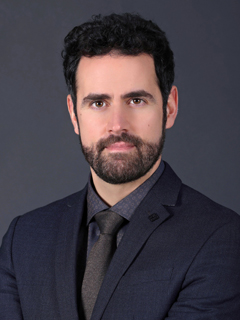HOW CAN WE HELP YOU? Call 1-800-TRY-CHOP
In This Section
Featured Research, Tonsillectomy, Gene Therapy, CAR T-Cell Therapy

It's officially summer! Kick off the season with this week's roundup of news highlights from around the Research Institute. First, find out who had a featured article in a prominent endocrinology journal. Read on to learn about research in controlling pain after tonsillectomy, and get details on a study of CRISPR-editing gene therapy for blood disorders. Check out a study on an immunotherapy target, and round out the news with updated information on the longevity of CAR T-cell therapy.
CRISPR Gene Editing Therapy Shows Continued Promise in Blood Disorders

Stephan A. Grupp, MD, PhD
In a late-breaking abstract presented at the European Hematology Association Congress, researchers led by CHOP presented data that show CRISPR gene editing therapy provides continued benefit up to three years after administration, in patients with transfusion-dependent beta thalassemia (TDT) and severe sickle cell disease (SCD). The safety profile was as expected for an autologous transplant, and potentially much safer than an allogeneic transplant.
"These data provide further evidence that this treatment has the potential to be transformational for patients with sickle cell disease and beta thalassemia," said senior abstract author Stephan A. Grupp, MD, PhD, section chief of the Cellular Therapy and Transplant Section, and inaugural director of the Susan S. and Stephen P. Kelly Center for Cancer Immunotherapy at CHOP. "Although we must continue to investigate the durability of these results, I am excited about the current data."
The study included 44 patients with TDT and 31 with SCD who received exa-cel (exagamglogene autotemcel), a one-time treatment that uses CRISPR gene editing to boost production of fetal hemoglobin to correct the defective gene for hemoglobin. At follow-up, which ranged from 1.2 to 37.2 months after exa-cel infusion, 42 TDT patients were transfusion-free. All 31 SCD patients were free of vaso-occlusive crises at follow-up, which ranged fromtwo to 32.3 months.
Learn more in the CHOP press release.
High-Dose Celecoxib Reduces Narcotic Use, Controls Pain After Tonsillectomy
Researchers at CHOP found that high-dose celecoxib is effective at controlling pain and reducing narcotic use in children after tonsillectomy. The findings, which appeared in Otolaryngology-Head and Neck Surgery, suggest the combination of celecoxib and acetaminophen can be used in children after tonsillectomy rather than ibuprofen and acetaminophen. Despite the effectiveness of ibuprofen, it potentially increases the bleeding risk after tonsillectomy.
First author Teresa Giordano, DNP, CRNP, a clinical outcomes research administrator in the Division of Otolaryngology at CHOP, and her team conducted a double-blind, randomized, placebo-controlled trial that included 172 patients randomized to receive celecoxib or placebo, twice daily, for up to 10 days after tonsillectomy. Patients also received acetaminophen and oxycodone as needed. They found that celecoxib controlled pain and reduced narcotic use – in the celecoxib group, oxycodone use was lower at all time points and had a 36% reduction in cumulative consumption.
"Since completing the study, patients over age 2 at CHOP are routinely prescribed celecoxib after tonsillectomy," Dr. Giordano said. "Future research should compare ibuprofen and celecoxib directly to evaluate side effects, bleeding rates, and analgesic efficacy."
Find out more in the CHOP press release.
JCEM Highlights Research Led by CHOP Researchers
For the week of June 21, the Journal of Clinical Endocrinology & Metabolism featured a paper by senior author Michael A. Levine, MD, Chief Emeritus of the Division of Endocrinology and Diabetes at CHOP. Dr. Levine and international collaborators described two novel PTH gene mutations in familial isolated hypoparathyroidism (FIH). The study involved case reports of two probands who presented before age 10 days with hypocalcemia and elevated phosphate levels.
While the first proband had low parathyroid hormone levels, the second had elevated levels, and was initially diagnosed with pseudohypoparathyroidism. The researchers conducted a genetic analysis on the probands and extended family members, which implicated two new mutations in FIH. The first proband had a heterozygous sequence change in exon 2 of the PTH gene, and the second proband had a homozygous nucleotide transition in PTH exon 3.
The researchers concluded that although PTH gene mutations are not a common cause of hypoparathyroidism, genetic testing may be warranted in if parathyroid hormone levels are high or low.

Nikolaos G. Sgourakis, PhD
Researchers Reveal Molecular Mechanics of Potential Immunotherapy Target
Scientists know MHC-I-related protein 1, or MR1, to be an important molecule for recognizing microbial infections, identifying cancerous cells versus healthy cells, and regulating autoimmune disease. But despite recent studies suggesting MR1 can also display cancer-specific metabolites that can serve as internal sensors for disease, the molecular mechanics of MR1 were previously unknown.
In a study published in Nature Chemical Biology, CHOP researchers elucidated this molecular basis and in particular, how chaperone molecules recognize and stabilize MR1 molecules. Just as major histocompatibility complex class I (MHC-I) molecules live on the surface of nearly all cells and present peptide antigens so our immune systems can detect bacteria, viruses, or developing tumors, MR1 molecules present smaller metabolites on its surface for surveillance by MR1-specific immune cells.
But through in vitro and in cell techniques, the researchers discovered MR1 operated a little differently from MHC-I: Unlike MHC-I, MR1 interacted at low affinity levels with the molecular chaperone TAPBPR whether it was loaded with presenting antigens or not. Nevertheless, these low-affinity interactions still enabled molecular chaperones to catalyze the loading and exchange of metabolite molecules directly on the MR1 surface.
"Our results provide a basis for utilizing molecular chaperones to stabilize MR1 molecules and to enable loading and presentation of antigens directly on the cell surface," said senior author Nikolaos G. Sgourakis, PhD, associate professor in the Center for Computational and Genomic Medicine at CHOP in a press release. "Future research should screen libraries of metabolites to see which show high affinity for binding to MR1. Researchers can then consider ways to increase MR1 surface expression, potentially by promoting more stable MR1/chaperone interactions via several approaches, such as the use of small molecules."
Learn more in the press release.
First CAR T-Cell Therapy Demonstrates Benefits Five Years Later
The first-ever approved CAR T-cell therapy, Kymriah (tisagenlecleucel) demonstrates durable remission and long-term survival five years after the treatment in children and young adults with relapsed or refractory B-cell acute lymphoblastic leukemia (B-ALL), according to new data presented at the 2022 European Hematology Association Congress. The findings build on work done at the University of Pennsylvania and CHOP, where Emily Whitehead was the first pediatric patient treated with CAR T-cell therapy. The new findings show that 55% of patients with relapsed or refractory B-ALL who were treated with CAR T-cell therapy were alive after more than five years, and 44% of those who reached remission within three months of infusion were still in remission at the five-year mark.
"The field has been waiting for the five-year data, a key landmark in assessing long-term benefit and the potential for cure for some patients," Dr. Grupp said.. "These results mark a moment of profound hope for children, young adults, and their families with relapsed or refractory B-cell ALL, as relapse after five years is rare. Since the approval of Kymriah in 2017, we have been able to offer a truly game-changing option to patients who previously faced a five-year survival rate of less than 10%."
Read the CHOP press release for more information.
ICYMI
Catch up on our headlines from our June 10 In the News:
- Autism Screening Disparities Persist in Pandemic's First Year
- Telemedicine Effective for Patients with Genetic Disease
- Researchers Identify Novel Factors in Silencing Fetal Hemoglobin
- Researchers Validate COVID-19 Exposure and Family Impact Scales to Measure Pandemic's Impact on AYAs
- CHOP and Penn Collaborate in New Center for Williams Syndrome Research and Care
Keep up with our news, stories, and updates in real time by following us on Twitter, Facebook, LinkedIn, or Instagram. Or subscribe to our newsletter to get an email sent every other Friday by signing up here.



